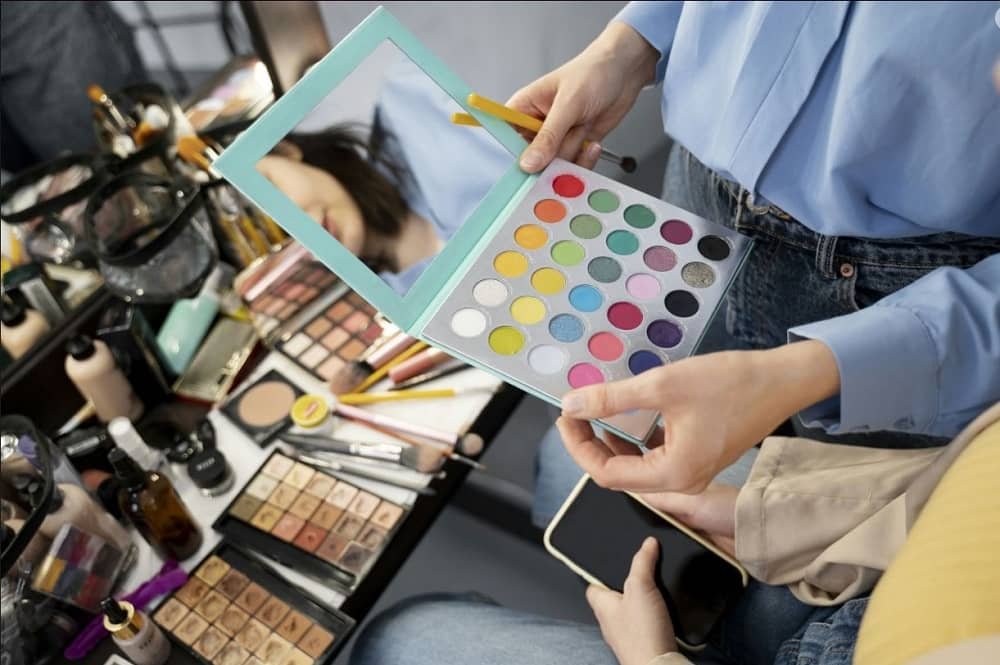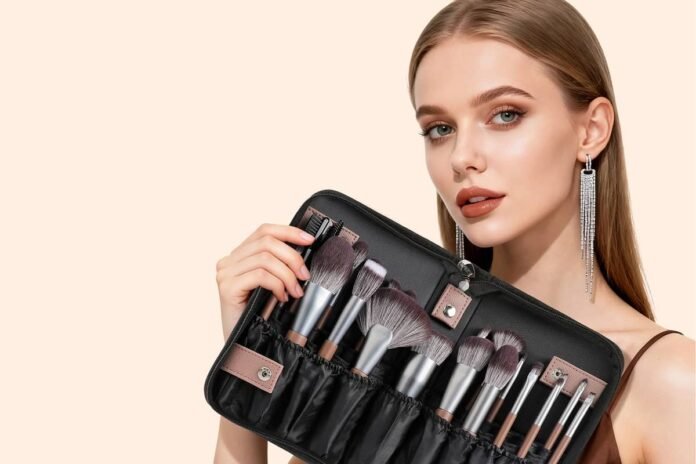Succeeding in the beauty industry doesn’t have to be filled with trepidation. Sure, the industry is booming (it is expected to increase 20% by 2026) and yes, there is a lot of competition between salons. BUT, this also means there is plenty of room to make your mark and carve out a successful career.
It is just a matter of adding the right qualifications to your arsenal and knowing how to get your name heard and recognised.
What is a Beautician?
Beauticians are basically individuals who are trained on how to provide hair care (styling, shampooing, scalp treatments, colouring and cutting) and beauty treatments (make-up, waxing, massages, manicures, pedicures, nail art etc.), as well as offer advice to clients on how best to take care of their hair, skin, nails and makeup. They can also provide more advanced treatments, including: electrolysis, laser therapy and permanent makeup.
What Do You Need To Become a Beautician?

Step One: Do your research
There are so many areas within the beauty industry that you can explore that it is easy to become lost or too broadly specialised. Sure, dabbling in everything could improve your employability, as you’ll have more job choices. However, doing everything could overstretch your skills.
For instance, instead of being outstanding at haircare (and building up a reputation); your skills could be seen as just ‘average’ as you won’t have had time to hone/improve your skills.
For this reason, we recommend training in several areas with a focus on one speciality e.g. hair and nails. This will allow you to strengthen your skills and stay on trend, whilst also allowing you to call yourself a true specialist because you’ll know all the latest techniques, styles and treatments.
Step Two: Review your skill set
There is more to the beauty industry than being good at hair and cosmetology. You’ve also got to have: a lot of physical stamina (think about it – you’ll be spending hours every day on your feet, performing treatments and even exercising your arms and legs as you do massages/waxing); great customer service skills, and amazing organisation and time management.
Your job after all, is to get clients to come back, so if they are met with someone who always runs late with appointments or whom can be abrupt when stressed; they won’t book again.
That is why you need to sit down and ask yourself: do you have what it takes to handle a salon environment?
Step Three: Qualifications
The surest way to succeed in the beauty industry is to equip your CV with an arsenal of qualifications so amazing that employers can’t say no. A bit dramatic yes, but qualifications can genuinely boost your job options and employability.
Now your route to achieving this can vary:
You can work your way up from the bottom and get apprenticeship in a salon. This will allow you to gain hands-on, valuable experience in a range of beauty specialities whilst you become qualified. These typically last 1-3 years, but we advise continuing your training afterwards so that you stay on top of the latest techniques, trends and products.
- Beauty schools – community colleges, technical schools and even cosmetology schools all offer programs both singularly i.e. in just one area, or as a full course covering everything (hairdressing, nail care and skin care). Full time, you can complete such programs in as little as nine months.
- Online beauty courses – similar to beauty schools, you can enroll onto a range of online beauty courses and broaden your portfolio. This step can be nicely paired with an apprenticeship or can even be done once you are qualified and working in a salon, as they can be completed at your own pace and from the comfort of your own home.
Beauty courses to complete
A lot of salons will expect you to have gained a NVQ Level 2 before you even begin training/doing an apprenticeship with them. Then under their care they will help you to work towards a NVQ Level 3.
And it is important that you get your Level 3, as there are some salons who will only accept you as a fully qualified beauty therapist if you’ve got this qualification.
Now to reach your Level 2, these are the beauty courses to complete:
- Level 2 NVQ Diploma in Beauty Techniques
- Level 2 NVQ Diploma in Beauty Therapy Services
- Level 2 NVQ Diploma in Hair and Beauty Services
- Level 2 NVQ Certificate in Beauty Salon Reception
From here you will be expected to get the following qualifications to begin working as a beauty therapist:
- Level 3 NVQ Diploma in Beauty Therapy (you’ll have the choice to study from makeup, nails and spa treatment)
- Level 3 NVQ Diploma in Advanced Beauty Therapy
- Level 3 Diploma in Beauty Therapy Treatments
These can vary a little depending on which specialist field you wish to explore, but they can provide you with a solid foundation of knowledge upon which to build, as you continue to develop your career.
And this is important, as the beauty industry is constantly evolving and changing. You need to be prepared to continue your training and improving your skillset (once you’ve qualified) so you can remain up-to-date and on trend.
Then of course, you should consider courses that can advance your career development. For instance, taking a Business Management or Accounting course can help you to become self-employed and manage your own business (including your finances).
These courses can easily be accessed online or at your local college. You can even enroll onto specialist business courses that have been designed purely for beauty therapists and beauticians.
Step Four: Consider your career

Many of your course and qualification choices will be influenced by where in the beauty industry you want to work. Do you simply want to work as a beauty therapist/beautician in a salon, spa, hotel or cruise ship, or do you dream of owning your own salon?
These are all things you will need to consider whilst you’re researching, as they will enable you to plan more efficiently.
Then there are alternative careers. Those you don’t automatically think of whilst you are training (don’t worry this list covers both the obvious and the not so obvious careers):
- Hairstylist – this includes shampooing, cutting, colouring and styling.
- Colourist – you can specialise in this service, and it can be the only one you offer (no need to cut or style).
- Nail technician – manicures, pedicures, polishing, nail extensions and nail art… you will offer it all.
- Esthetician – this role involves cleansing and beautifying skin by giving client’s facials, full body treatments, head and neck massages and make-up application. It can also extend to waxing and – with proper training – laser treatments.
- Massage therapist – in this role you can help clients suffering with painful ailments, overworked muscles, sports injuries and stress, by offering them a range of massage treatments that will manipulate their soft-tissue muscles.
- Electrologist – in this role, you would be expected to use electrical stimulation and needles to damage hair follicles so they don’t grow back in the same location.
- Makeup artist – there is a lot of scope with this job as you can offer this service within salons or spas, or you can try working in the theatre, photography, movie, fashion, music or TV industries. And this particular job route is a great way to build up your reputation and get your name passed around.
Step Five: Keep learning
Even when you’re qualified, your learning journey won’t be over. To excel in this industry – and build a name for yourself – it is important to always be learning, so you can proudly/confidently say you are an expert in your chosen field. Get behind on trends or the latest techniques and clients could lose faith in your skills.
Good Ways To Maximise Your Training and Career Opportunities, includes:
- Becoming an expert on the products you recommend
- Offering more than an average experience – for instance, you could learn about the different stress-relief pressure points on the neck and scalp, thus enhancing their enjoyment
- Attending new colouring, cutting and styling classes – see a seminar? Attend it. Keep yourself in the know.
- Looking at other courses beyond beauty – accounting, business management, marketing and how to create business plans.
- Not getting comfortable – don’t let yourself fall into a rut. It doesn’t take much for clients to move or switch salons. You need to get inventive when attracting new clients. That is why you should take advantage of every networking opportunity and use every chance to showcase your portfolio. Consider using mediums such as social media e.g. Facebook, Twitter, Instagram, SnapChat etc. where you can post ads and pics, as well as initiate email marketing amongst reoccurring clients.
- Creating a portfolio – this is essential when moving roles, as your portfolio will show potential employers all your skills. The key is to tailor your portfolio to meet the expectations of each individual job you are applying for.
As you can see, it is possible to build a successful career within the beauty industry. You’ve just got to be prepared to put in the work. Do that and all the training, the qualifications and the endless hours of work experience, will all help to give you a CV/portfolio that will place you leaps ahead of your competition.








